Today, we’re going to be talking about the curved “Janus” sharpeners made by A.W. Faber and Faber-Castell.

A.W. Faber 4046

From some research on the internet, it would appear as though the 4046 was manufactured between 1930 and 1935. My correspondence with the Faber-Castell historian revealed that first 4046s were probably sold in 1935. I have seen two variants: one where the corners are a little rounded and another where the corners and sharp. The historian verified my findings.
The blade on the 4046 has a single caret ( < ) on one side and a double caret ( >> ) on the other.
Production of the 4046 was stopped temporarily during WWII, but resumed after the war. It was now produced in two different metals: brass and duralumin.
Patent #: DE964034 is for a curved sharpener. Gunthur Schmidt of Lexikaliker mentions (albeit in German, which I know little of) that this patent showcases a curved blade sharpener with what appears to be a smaller hole for sharpening leadholders. This makes use of both sides of the blade.
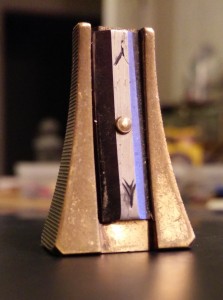 I managed to purchase an A.W. Faber 4046 off of Etsy for a decent price. Faber 4046s go for between $40 and $100 depending on condition.
I managed to purchase an A.W. Faber 4046 off of Etsy for a decent price. Faber 4046s go for between $40 and $100 depending on condition.
Mine is a fairly worn example.The brass is showing signs of uneven oxidation. I was a bit concerned by the corners, edges and jimping, but the metal itself has worn down very little.
The blade itself has no rust, which really surprised me due to the high carbon content of the blades. There is some discoloration in some areas, though, but none that would change its usability.
One thing to note about purchasing a used sharpener is that the blade is you cannot resharpen the blade. This will change the distance between the blade and the edge of the sharpener, causing an oddly shaped pencil point.
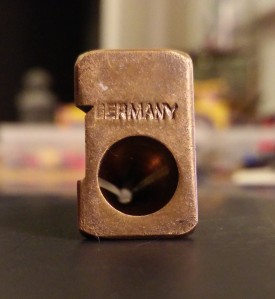 If there was anything that disappointed me about the purchase, it was the condition of the screw. It looked as though someone used a screwdriver that was too small and completely mangled the head of the screw. I have not attempted to remove it yet, but once I do, I will be trying to find a replacement at once.
If there was anything that disappointed me about the purchase, it was the condition of the screw. It looked as though someone used a screwdriver that was too small and completely mangled the head of the screw. I have not attempted to remove it yet, but once I do, I will be trying to find a replacement at once.
One interesting thing to note is that the place of manufacture stamp. Since it says “Germany”, we know for sure that it was produced before the Second World War or after reunification, of which the latter would be improbable.
I was quite impressed by the curvature of the sharpener. It’s just gorgeous at every angle.
Sharpening a pencil is quite easy. The knurling is grippy enough that the sharpener stays firm in the hand. The blade is a bit dull, but it has enough life in it to give a pencil a point. I decided, for my first pencil, to sharpen a Mitsubishi 9800.
Sharpening produced a mound of shavings. The shavings are very thin, but they are not very consistent. However, there were consistently strings of 5 to 10cm. The graphite shavings were not as nice though. There were some larger chunks, and it looked like pieces were chipped off.
The tip is quite nice. When compared to a pencil sharpened by the Angel-5, it is obviously convex. The tip length is similar, though the Janus gives a more consistent tip.
Faber-Castell 4048
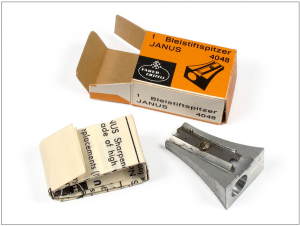
The Faber 4048 was produced from around 1965 till the early 1970s.
The Faber 4048 came in two varieties: one made of brass and one made of duralumin. They both came in a small yellow box wrapped in waxed paper instructions. The instructions appear to be the same for both versions.
The instructions are written in 5 different languages: German, English, French, Spanish, and Italian.

Transcribed: “You have made an excellent choice in the JANUS Sharpener No. 4048. It is a sharpener of precision. The double edged reversible blade is made of high quality steel, will provide you with constant long, needle-sharp points.
The blade can be changed simply and speedily, replacements (No. 4049) being obtainable through any good stationer or drawing office dealer.
Please do not attempt to remove any lead points, which may be caught under the blade, with other than a matchstick or other non metallic implement. Better still, loosen the screw and remove the particle of lead.”
The box itself is completely in German. There’s a picture of the sharpener on the front, with the Faber-Castell logo on the bottom left corner.
The edges of the box are either plain or have the item name on them. The box below was made in the 1960s. Boxes are same for both the brass and duralumin versions.
The blades on the 4048 are different from that of the 4046. The arrows are now gone and the blade now has two indentations at each end. Further, the blade is screwed in through the top rather than the bottom. I have heard that the blades are interchangeable though.
Faber 4047
The 4047 were the replacement blades made for the 4046 and the 4047. They came in a small nickel tube. They supposedly contained half a dozen, as per the ad above, but for the most part, I have seen them containing three (perhaps due to use). Something else to note is that the replacement blades, at some point, having the caret symbols.

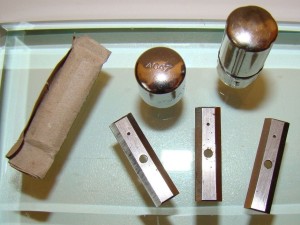
Faber 4049

The Faber 4049 appears to be the second variation of the replacement blades. Green boxes with white caps held five(?) blades. These were made for the Faber 4048 and the blades can most easily be distinguished from the Faber 4047 blades by the inclusion of the half circle cutouts at each end.
Picture Credit:
(1) www.lexikaliker.de
(2) My Pencils Draw Worlds

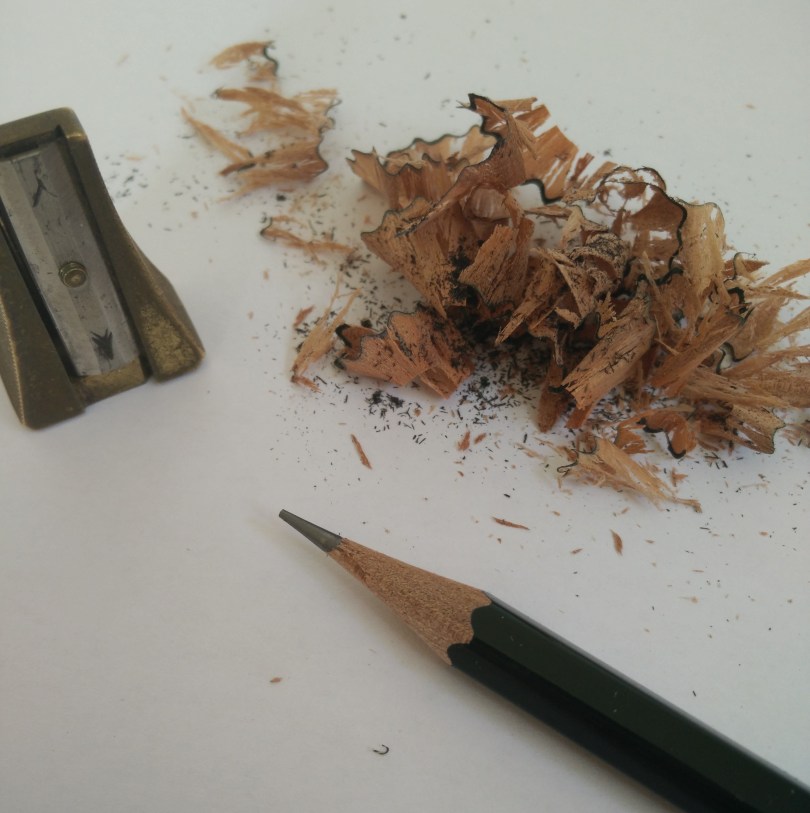












Can you help me in locating and buying spare blades for JANUS 4048 please? Thank you.
LikeLike
I will let you know if I find any. They show up very infrequently.
LikeLike
Also interested in finding a 4048 as well as replacement blades for the 4046
LikeLike
I’ll let you know if I see any good deals!
LikeLike